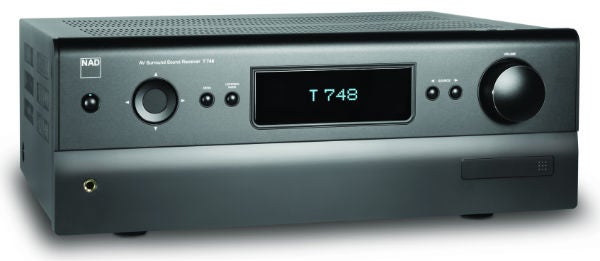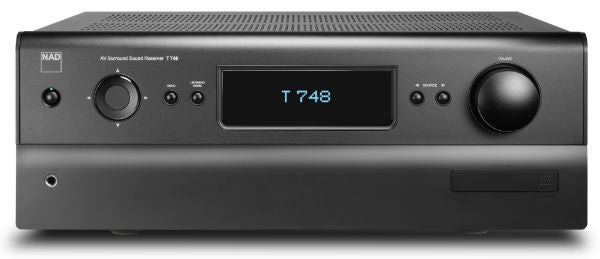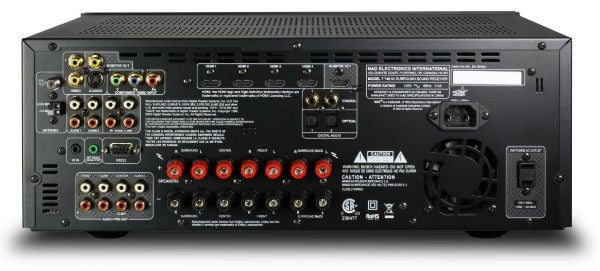NAD T748 Review
NAD T748
NAD’s 7.1 AV receiver is a classy customer but surprisingly limited for the money

Verdict
Pros
- Stylish and well built
- Smooth, controlled sound
- Auto calibration
Cons
- Not as powerful or dynamic as some rivals
- Limited connections for the money
- Rudimentary onscreen display
Key Specifications
- Review Price: £795.00
- Dolby True HD & DTS HD Master Audio decoding
- 7 x 40W power
- Auto Calibration
- Four 3D-ready HDMI inputs
- EARS surround sound
The T748 from New Acoustic Dimension (or NAD to me and you) is a 7.1-channel AV receiver, described by its creators as ‘performance driven’. That means they’ve spent more time nailing the sound quality and less time cramming it with features that bump up the price, which may well be music to the ears of home cinema purists whose networking and multimedia needs might already be catered for by other kit.
The T748 is blessed with NAD’s distinctive sense of style, which favours faintly retro simplicity over flashy exuberance, and build quality is fantastic. It’s styled in a classy charcoal grey finish (also available in silver) with a subtly curved top edge and a large Vacuum Fluorescent Display dominating the front panel. On either side of this you’ll find a few discreet buttons that let you toggle through sources, listening modes and control the onscreen menu. However, you won’t find any USB or HDMI ports – composite, S-video, analogue stereo and 3.5mm minijack are the only front-facing inputs (the minijack doubles as the setup mic port).
The rear panel sports fewer connections than you might expect for an £800 AV receiver. There are four HDMI inputs (all v1.4) which is a decent number but the same as the £200 RX-V371 – we want more at this price. They’re joined by four digital audio inputs (two optical and two coaxial) plus component, two composite and S-video inputs. You get three sets of analogue stereo inputs and one output, plus a set of 7.1 pre-outs that will let you pass unamplified signals to an external amp for even more muscle. 
Other connections include FM and AM radio aerial inputs, IR input, RS232, an MP Dock port for NAD’s IPD iPod dock and a socket for NAD’s DB2 DAB radio module. Binding posts are provided for all seven channels. There are no networking features on board, hence the lack of an Ethernet port.
Because all of the T748’s HDMI sockets are v1.4, it’s fully geared up to pass 3D images through to your TV, as well as supporting Audio Return Channel and CEC. It’ll also convert analogue video signals and output them from the HDMI socket.
Naturally it can also decode any Dolby and DTS format, including Dolby True HD and DTS HD Master Audio, plus stereo material can be converted to pseudo surround using NAD’s EARS mode, Dolby Pro Logic IIx or NEO:6 (but there’s no ‘front height’ technology like Pro Logic IIz). Enhanced Stereo plays music through all speakers. Power output is quoted at a modest 7 x 40W, although in stereo mode that’s upped to 2 x 80W.
Setup is simple thanks to the built-in Auto Calibration. Using the supplied microphone and test tones, it sets the appropriate noise level, number of speakers, distances, levels, sizes and equalisation (bass/treble levels) for your room automatically. It’s a set-and-forget process, perfect if you hate the thought of tweaking everything manually.
But if you’re not happy with the results then you can turn off the EQ after calibration is complete, or set the parameters yourself in the setup menu. This comes in the form of a rudimentary onscreen display, with blocky lettering over a black background. Its ugly appearance is a far cry from the slick menus of Onkyo and Denon, but it’s responsive and easy to follow.
Within it, you can tinker with the speaker settings, configure the inputs, alter listening modes and loads more – despite its simple appearance, it’s very thorough. Also useful is that it remembers your settings for each source input.

The T748 comes with an attractive, weighty remote. It’s covered in rubbery, tactile buttons and a helpfully placed menu control pad. Button size and labelling is excellent, and the row of ‘device selector’ keys along the top is useful. It can also be used to control other NAD components.
The T748 proves its worth from the very beginning of Return of the Jedi on Blu-ray. John Williams’ iconic theme over the title crawl is relayed with such force and grandeur that it’ll make the hairs on the back of your neck stand on end. The brass is crisp and cutting yet underpinned by rich bottom end, and this intensity is matched later on by Vader’s Imperial March, which sounds more menacing than ever.
From then on, the NAD continues the great work, tearing into the soundtrack with aplomb. It’s a dextrous performer that’s just as comfortable with quiet dialogue-driven scenes as it is with energetic action sequences, and sounds more powerful than its 7 x 40W rating suggests.
Luke and co’s escape from Jabba’s clutches is a real thrill ride – blaster shots fizz around the soundstage with vibrant energy and Jabba’s barge explodes with a well-controlled boom that really does shake the room. There’s a thrilling tautness and cohesion about the effects presentation, allowing you to lose yourself in a bubble of childhood nostalgia.
The Speeder bike chase through the forest of Endor is equally exhilarating, giving the T748 a chance to show off its smooth steering as raspy engines career in every direction. When the hapless Stormtroopers smash into trees, the explosions are deep and punchy, while the openness, sense of space and accurate positioning makes the overall presentation hard to dislike.
But during Luke’s conversation with Obi-Wan, the T748 shows its sensitive side. It shapes Alec Guinness’ distinctive voice with care and attention to detail, picking out every vowel and consonant without sounding nasal or sibilant. Jabba’s dulcet tones have real presence too, thanks to the deep bass layered underneath his voice.
The T748 also gets a decent grip on detail, drawing out the movie’s subtle ambience and high-frequency effects with the sort of refinement you’d expect at this price. That goes for every channel too. Surround information is beautifully presented, particularly the scenes set on Endor – the creature calls echoing all around the soundstage effortlessly convey a sense of distance and expansion.
Its performance remains well controlled under duress, refusing to buckle when the volume starts to climb towards anti-social levels. And in the stereo domain the T748’s smooth, open character does lovely things to music, resulting in a sound that’s clean and detailed but not clinical – the natural warmth and dynamism puts paid to that. Instruments and vocals actually sound like instruments and vocals, while the timing and tightness are up there with the best at this price.
Any negatives? Well it’s an accomplished performer all round, but didn’t engage and bewitch us to quite the same extent as the Onkyo TX-NR1009 or the Marantz SR7005, both of which offer greater power, dynamism and detail.
Verdict
NAD’s T748 is an excellent performer, delivering exciting home cinema sound and smooth music playback. It’s also distinctively stylish and impressively built, which counts for a lot in our book.
However, at this sort of money we would have expected more connections and a better onscreen operating system, given that there are slicker and better-equipped amps on the market in the same price ball-park. And although we appreciate NAD’s performance-over-features approach, we can’t deny being a little disappointed not to find DLNA streaming or internet radio on the spec sheet.
But if those things aren’t crucial, then the T748’s masterful performance will make this feel like money well spent.
Trusted Score
Score in detail
-
Performance 8
-
Features 7
-
Value 7
-
Sound Quality 8
-
Design 9

